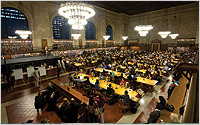 Last May, 500 people met in the New York Public Library’s main branch and stayed there all night. Gaming, not reading, was the agenda for the evening.
Last May, 500 people met in the New York Public Library’s main branch and stayed there all night. Gaming, not reading, was the agenda for the evening.
The crowd had
gathered to help launch “Find The Future: The Game,” a social game and mobile app created in honor of the library’s 100 years in the Stephen A. Schwarzman Building in midtown
Manhattan.
Caro Llewellyn, producer of the Library’s Centennial celebration, explains that the game was designed in part to highlight the library’s substantial collection of
historical artifacts, ranging from Jack Kerouac’s glasses to a letter opener made from the paw of Charles Dickens’ cat.
“That was the thing that I really wanted to get
across with the Centennial — the diversity of the objects in the library,” Llewellyn says. “People traditionally think that it’s just about books.”
By creating
the Find the Future game and app, the library also hoped to engage a younger crowd. In the end, Llewellyn says, the majority of the people who applied to take part in the inaugural Find the Future
game night were between 18 and 35. Out of 5,000 applicants, 500 players were chosen on the basis of creativity and imagination to be the first to play the game in the overnight event.
Part
scavenger hunt and part free-write, Find the Future can be played remotely or at the library, alone or en masse. Players are given “missions” to find various objects around the library,
and QR codes placed near these object allows players to reveal a “quest” (a written challenge) using a smartphone.
In one mission, players are instructed to head to the
library’s copy of the Declaration of Independence. Here, they scan a QR code that asks them to write their own personal declarations, drawing inspiration from the original document before them,
handwritten by Thomas Jefferson. Other quests asked players to create visual responses. Gaming, clearly, can be much more than sitting on the couch, controller in hand.
Last May 20, the
night of the game’s all-night kickoff, players were given the task of completing all 100 of the game’s quests. In doing so, the players “unlocked” the quests to the rest of the
public, who could download the Find the Future app and play the game in the months to come.
Find the Future was created by renowned game designer and researcher Jane McGonigal, who last
year published the best-selling book, Reality Is Broken: Why Games Make Us Better and How They Can Change the World. McGonigal believes games can and should be used to solve real-world
problems. This is possible, she contends, in large part because games can inspire real-life collaboration.
“As a society, we may feel increasingly disconnected from family, friends
and neighbors — but, as gamers, we are adopting strategies to reverse the phenomenon,” McGonigal writes in Reality Is Broken.
Llewellyn says she certainly saw a strong spirit of
collaboration the night the library opened its doors for the Find the Future gamers. The 500 players didn’t learn how the game worked until they arrived at the event, and the majority of them
had never met one another before that evening. And yet, they jumped right in and began working in groups to complete the quests before them.
“It was inspiring,” Llewellyn says.
“It was incredible to see how people worked together.”
At the start of the night, in the library’s main reading room, McGonigal explained the rules of the game and the
overarching goal: completion of all 100 quests, which would then be bound into a single handmade volume. McGonigal emphasized that this was a unique goal.
“Find the Future is the
first game in the world in which winning means writing a book,” she told them. “And everyone in this room, if you rise to the occasion, will write part of this book.”
That
they did. With the help of snacks, tea, coffee and Red Bull, the players explored the library’s stacks, found QR codes and tackled the prompts before them. At 6 a.m., the players were released
from the library, quests complete.
The Find the Future book, 100 Ways to Make History: May 20th, 2011, is housed in the library’s Rare Books Division.
advertisement
advertisement